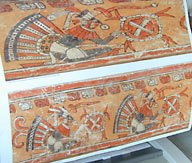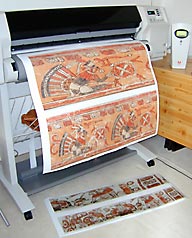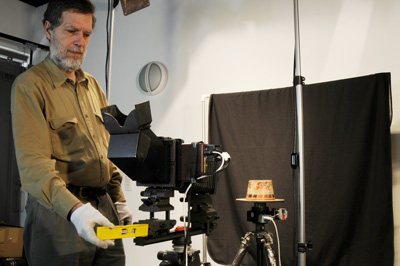Recent rollout photographs of previously unpublished Classic Mayan vases from Highland Guatemala. Photographed by the F.L.A.A.R. Photo Archive
  |
The top image reveals the distortion possible when the rollout is not properly calculated. The rollout above is elongated. This means that the speed of the turntable is not properly coordinated with the speed of the photography. The rollout below is the direct digital rollout with everything coordinated by a computer which can measure the proper rotational speed. Since the direct digital rollout camera made by BetterLight calculates the precise turntable speed accurately, the direct digital rollouts from this camera do not show the distortion of elongation or compression. In order to show you a sample we had to deliberately distort the image using a PostScript interpreter on the wide format printer. This is a 600 dpi color digital printer. All printers of this kind are made to reproduce 600 dpi quality from about 120 dpi of actual data. The RIP (PostScript RIP, described in www.FineArtGicleePrinters.org) is capable of taking the 120 dpi and turning it into 600 dpi. If you attempt to feed the printer a full 600 dpi of data the system cannot absorb a file with that much MB. Indeed the maximum you can feed the printer is about 225 dpi. |
 |
| Here is what happens when you feed the printer 250 dpi. It takes a portion of the picture, eliminates all the rest of the image; it then takes the selected portion and stretches this to cover the entire page size you selected (in this case 34 inches wide for 36 inch wide paper for a large format printer). |
This is not a fault of the printer, it is merely the RIP telling you that you have fed it too much data.
This stretching we do to simulate a hand-made rollout camera and to show you the problems if you use trial and error. Your images will be distorted. The distortion may be only 5% or 10% but you can see the distortion clearly in many published images.
You can eliminate the distortion if you have an on-board calculator (such as the 70mm film-based rollout cameras made in Belgium). You still have a soft focus (a result of the moving image and moving film) but you have an image of correct proportions.
Why is it important to get correct proportions? If you are a scholar you need to see the precise style, and proportion is part of that style. A distorted rollout distorts the original regional Mayan style. Thus it is helpful to re-photograph the vases that were distorted by earlier hand-made rollout cameras. Now that computer-controlled cameras are available there is no need to depend on trial and error. Cameras that use 120 size film, or 220 film, are calculated by hand and their results tend to be distorted. Plus you can't enlarge a distorted image to a large size: you see the imprecise aspect of the image as you enlarge it. But with a circumferential rollout from a BetterLight Pano/WideView you can enlarge these to 4 to 5 feet high and 6 to 9 yards long.
 |
Maya vase rollouts are more accurate when calculated with a computer and done digitally. All books nowadays and of course all PDFs are digital anyway. It makes little sense to use 120 film, 220 film, or 70mm film. FLAAR has rollout cameras for all these types of film (we have two film rollout cameras and two digital rollout cameras). Here is our most recent digital rollout camera for Maya vases. In this studio we are recording the vases and plates of La Ruta Maya Conservation Foundation. Yes, plates too, Nicholas Hellmuth is the first photographer we are aware of who did rollouts of both the inside and outside of Maya plates. If your museum or university of project wishes to have rollouts, FLAAR equipment is fully portable and our bilingual photography team can do this rollout photography anywhere in the world. |
New page format posted November 17, 2009